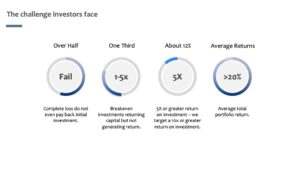If you have ever tried pitching angel investors or VC’s, you know the process is painful.
Investors want a lot of information, and you are guaranteed not to have enough time to communicate everything about your business or tick every box. And, if you take the time to ask 100 angel investors what they want to see in a pitch, you will get 100 answers.
Searching for “how to pitch angels investors” on google is even more useless, you will get reliably vague tips about how to woo investors. Some will suggest fun pitches and trying desperately to stand out. They will tell you to be memorable. The key is to know what investors want and how to pitch angel investors.
Here is the thing: if you want to raise money you have to tell a good story and have a great pitch. And the key to a good pitch, one that stands out, is to tell investors how you will reliably make them money. You get bonus points if you can convince them they will want to tell their friends they invested in your business.
Pitches are short – due diligence is long
Often you will have only a few minutes to pitch. Even if the organization you are pitching gives you more time on the clock, they are unlikely to give you more brain time.
Your pitch must intrigue investors early and draw them in so that they want to ask questions.
There is another value to this: if you cannot explain to an investor in 8 minutes what your company is, what it does and why investors should care you can’t possibly explain it to your prospective customers. They typically will give you 8 seconds.
Why do all investors have different expectations?
The primary reason for this? They don’t know what they want. Think about it: how do you explain to someone how to inspire you? This is not easy.
So, investors don’t know what they want exactly, but they know it when they see it. They all say that they need specific, detailed information about you and your business before they invest.
But the role of the pitch is not to give them that information.
Instead, the role of the pitch is to spark interest so that investors will spend the time to get to know your business. Or another way to say this: the role of the pitch is to get investors to ask questions.
When you pitch the angels, you typically have 6-10 minutes. No matter how simple your business is, you cannot possibly fit everything an investor wants in that timeframe.
You will be hard-pressed to fit that into a two-hour deep dive (which is why due diligence takes so long).
Still, pitch after pitch is crammed full of eight-point font descriptions of every nuance and every feature. Even worse, if you do try to put everything into your pitch, you end up with a long list of data that nobody can understand – you end up turning them off.
Let me restate that: if you try to give the investors all of the information they want in the pitch, they will most likely stop listening to you, not express interest and not invest. This is how to create a great pitch to the angels.
We have reviewed thousands of pitches and can usually tell within the first few minutes who will interest our investors. So here is
What we have learned about pitching investors.
1. Know that your role is to show investors a great way to make more money
Keep in mind that investors are not interested in you or what you do. Their lack of interest sounds paradoxical, but they are interested in themselves and how they will make money.
Your job is to show investors how they will make money.
Your pitch should present a business idea that:
- We can easily understand.
- Solves a problem
- Sells into a big market.
And show that you have the team/capabilities to deliver.
Remember that investors take a huge risk when investing in startup companies, your role is to show them that you are a great opportunity. Especially if you are pitching angel investors, the challenge for them is very high: the majority of the companies they invest in, even when they KNOW the company will perform amazingly well, fail completely.

Angel Investor returns.
(Want to know what it looks like from the Angel perspective, here is our sheet for evaluating startups).
2. Please, please, do not try to answer all questions in advance
At the Westchester Angels, we had a company present us with an idea for wind turbines. The idea was attractive to a few of our investors, but the pitch was a disaster.
The CEO showed slide after slide of data and information that none of us could digest.
At the end of the pitch, there was not one person interested in learning more about this business or working with the entrepreneur.
We tried to give the CEO advice on his pitch and explain how to improve it; he wouldn’t listen. He explained that it was impossible to tell a clear story because he had to “prophylactically” answer the questions that would come up.
Not many investors use that phrase, but many try to do the same thing: answer every question that might ever come up.
Don’t do that.
Even if you have every answer, providing them upfront will turn investors off. There is an element of understanding your audience here: if you are pitching angel investors the expectation and often sophistication of the investor is different than when you are pitching VC’s. Know your audience.
Regardless, you can’t give any investor everything they want in an initial pitch. This is true even though investors may tell you they want every answer.
(you may also be interested in our list of what Angel Investors Look For In A Pitch).
And if you were to answer all of the questions, they wouldn’t ask any more questions, and you wouldn’t have the conversation you want to have after the pitch!
Which brings me to:
3. Know the role of the pitch and focus on getting it to its job.
You will not get investment as a result of your pitch. I have never seen that happen.
The role of the pitch is to get to the next conversation. That subsequent conversation can happen immediately after the pitch in the Q&A session. You want investors to ask probing questions, that means they are interested.
The role of Q&A is again progression to the next conversation, which in our case takes place at the bar downstairs.
DO NOT SKIP THE BAR, or whatever the equivalent may be.
I have never seen a pitch lead to an investment; I have seen a bar conversation lead to an investment.
Mostly though each conversation leads to the next, the pitch is the first one. Use it to get to the next conversation.
4. Remember you are pitching to humans who are looking for inspiration
I was on a panel of angel investors watching lousy pitch after bad pitch when one of my fellow panelists turned to me and said:
“don’t they get it? We want to go to a cocktail party and be able to say that we invested in that great company in the beginning.”
And therein lies the clue to connecting with investors: they want to be the hero.
They won’t ever use this language, by the way, but that is what they want. When they are listening to an 8-minute pitch, they are looking for the numbers, evidence, and a great idea.
But, mostly, they are looking for a spark of confidence that you are the next great entrepreneur and that by working with you, they transform themselves into better entrepreneurs, advisors, investors, whatever.
People, including investors, don’t remember facts. Facts matter, but they don’t connect. You must connect with investors with a great story. It should include the compelling market challenge but also the clear pathway to investors making money.
**Good pitches don’t inform or bombard with facts; they inspire.**
5. Get the content of your investor pitch right
Content does matter. There are eleven concepts that you want to communicate.
You don’t have to communicate all of the detail. But you do have to address each concept, and you must be ready for rigorous questions around each topic.
- Generally, the areas of interest are:
- A solid attention-grabbing introduction (Investors aren’t looking for this, per se, but it helps.
- The “pain” or market need.
- The solution (ONE SLIDE, maybe two. NOT the whole presentation).
- The addressable market size
- The business model, please show us how you make money.
- Experience in the market/market validation – the more, the better.
- Channels to market/market strategy
- Competition and how you compare, why you will win
- The Team – very important.
- Forecast / Plans
- Exit Strategy, remember investors only make money at the exit, so they want to know one is planned.
- The Ask – sadly often forgotten.
6. Be professional and pitch investors well
We know that the startup culture is one of ripped jeans and old t-shirts. But show us that you can also dress professionally as well.
Practice your pitch so that it flows. Go through it 2-3, 100 times. Try it on your friends. Aim for concise over wordy. Work on engaging the audience, speaking to them rather than sounding rehearsed.
I have seen some very poor presenters do well if the content is strong enough it can carry you. But don’t count on that. A professional presentation is within your control, so do what you can to show investors that you will do everything in your power to make the business work.
Don’t worry too much about being nervous or stumbling over a few words here and there. Preparation shows. Professionalism shows. Let it work for you.
7. Follow the rules to pitching angels
I generally lead our meetings with the support of our other partners, but I am the emcee. At one meeting, none of the other partners could make it. I was there on my own.
And one of the presenters decided not to follow the rules. We allow an 8-minute pitch and about 8 minutes for Q&A. We like this format. It is a good test of how well you present and gives us a few minutes for that next conversation.
That evening one of the presenters decided to ignore our rules and present for 16 minutes. And as much as I tried to be polite, he wouldn’t shut up.
He had a great product we loved.
He solved a real need that we understood.
But his behavior was awful.
So he lost the investment.
And know this: angel investors talk. We have a monthly conference call with other groups, and I assure you I was not quiet about my annoyance with this presenter.
Just follow the rules. It isn’t that hard.
So those are my observations on how to pitch angels. I’ll add to this as more occur to me.
In the meantime… good luck! With all of these requirements and constraints, the truth is we want entrepreneurs to succeed. We are in the angel investing world because we are passionate about startups and passionate about seeing your company grow. You just have to show us the opportunity.

Download Our
Pitch Guide Here
This is best for pitching angel investors, but you may find it more generally useful as well.


Recent Comments